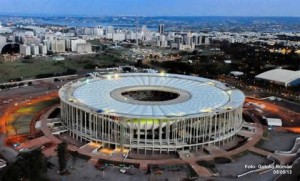 The FIFA 2014 World Cup in Brazil has so far been the biggest and most expensive tournament in soccer history. With ticket sales almost reaching full capacity and an estimate of over 500,000 visitors from around the world, the economic impact of this year’s World Cup has reached an all-time high. However, keeping this incredible event eco-friendly has been a daunting task with large amounts of pressure from environmental protection agencies around the world.
The FIFA 2014 World Cup in Brazil has so far been the biggest and most expensive tournament in soccer history. With ticket sales almost reaching full capacity and an estimate of over 500,000 visitors from around the world, the economic impact of this year’s World Cup has reached an all-time high. However, keeping this incredible event eco-friendly has been a daunting task with large amounts of pressure from environmental protection agencies around the world.
This year’s World Cup has exceeded CO2 emissions of the last World Cup in South Africa by over 1 million tons of CO2 with a total of 2.7 million tons. According to a study done by FIFA, and estimated 60% of the CO2 emissions are produced by transportation of personnel, equipment, teams, and fans coming from all over the world. Measures have been made to help prevent and offset the environmental impact such as building stadiums that run on solar power, rainwater collection facilities, and a large recycling program, but with any event on a scale and this grand is always a large environmental toll.
 UNEP and Brazil’s Ministries of Environment, Sports, Tourism, and Social Development have teamed up to create and promote Green Passport Tours which promotes sustainable tourism specifically for World Cup 2014. FIFA’s head of corporate social responsibility, Federico Addiechi, pledges to offset 100% of the 2.7 million tons of CO2 emissions starting next summer with programs in reforestation and investment in wind energy and hydroelectric power.
UNEP and Brazil’s Ministries of Environment, Sports, Tourism, and Social Development have teamed up to create and promote Green Passport Tours which promotes sustainable tourism specifically for World Cup 2014. FIFA’s head of corporate social responsibility, Federico Addiechi, pledges to offset 100% of the 2.7 million tons of CO2 emissions starting next summer with programs in reforestation and investment in wind energy and hydroelectric power.
Even with the changes that have been made to create a more sustainable World Cup, significant environmental improvements need to be made when hosting an event like the Olympics or World Cup; which emissions can equate to having 560,000 cars on the road for a year or the burning of 1.46 million tons of coal. Aside from emissions, the materials that were needed to improve Brazil’s infrastructure, build the stadiums and other buildings, power all telecommunications and TVs around the world, which has reached up to 3.2 billion viewers according to Bloomberg, also added to the degradation of the environment. With over $4 billion in untaxed revenue FIFA received for this World Cup alone, more time and money should be allocated towards the sustainability of our environment.
Environmental improvements for future World Cups have great potential if more leadership and requirements from FIFA were to be made. With hosting the World Cup being highly desirable for countries around the world, requiring more and stricter environmental standards for the host country would drastically improve environmental quality for these events. FIFA holds great power with its sponsors and host country and has the ability to use that leverage with changes such as requiring an amount of funding specifically for environmental health, eco architectural standards for all new stadiums, positioning all new stadiums to be near public transportation for less vehicle carbon emissions, or requiring an environmental advisor to assist the planning process for stadiums, hospitality and transportation.
All of these changes have the potential of making a large positive impact on the environment along with creating more awareness to the importance of sustainability. With great the support of FIFA, the World Cup could become an event not just for the love of soccer, but for new sustainable ideas that could be showcased to the world.



